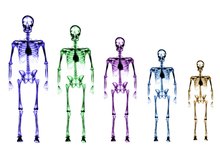My Child Is Complaining of Pain in His Legs
Leg pain in children often prompts a visit to the doctor 3. Pain in the leg can arise from multiple causes, ranging from mild, temporary conditions to serious medical disorders. As a parent or caregiver, you need to know when to be concerned about a child’s leg pain. Clues to the cause of a child’s leg pain include the severity of the pain, accompanying symptoms and the length of time the pain has lasted.
If you are experiencing serious medical symptoms, seek emergency treatment immediately.
Periodic Leg Pain
Some causes of leg pain in a child are not serious and will go away on their own. For example, growing pains are leg aches that occur off and on, usually in children ages 3 to 10 years old. Growing pains are usually brief, although recurrent, and often occur in the shins, calves or thighs at night. The cause of growing pains is unknown. Common treatments include massage, heat and mild pain relievers such as acetaminophen (Tylenol) or ibuprofen (Advil and Motrin). If the leg pain is only on one side or if joint pain is present, it is probably not growing pains and should be checked by the child's doctor.
- Some causes of leg pain in a child are not serious and will go away on their own.
- For example, growing pains are leg aches that occur off and on, usually in children ages 3 to 10 years old.
Severe or Rapidly Worsening Pain
Causes of Leg Muscle Stiffness and Pain in Children
Learn More
When your child suddenly complains of severe leg pain, several causes are possible. The pain may be due to an injury, such as a sprain or a bone fracture. Injuries are often obvious but sometimes cause only subtle symptoms, such as a slight limp or mild swelling. A developing infection of in a child's ankle, knee, hip or leg bones is another cause of severe pain. In this case, the pain typically gets progressively worse over a short time and often causes limping. If leg pain is severe, worsening or causing a limp, get an immediate medical evaluation.
- When your child suddenly complains of severe leg pain, several causes are possible.
- In this case, the pain typically gets progressively worse over a short time and often causes limping.
Pain That Remains
Leg pain that doesn't go away is cause for concern. Inflammatory conditions such as juvenile arthritis and lupus often cause pain in multiple joints, morning stiffness and accompanying symptoms, such as fevers and rash. Tumors in the bones of the leg can also cause persistent pain and tenderness, which is typically worse at night and often accompanied by fevers and weight loss. Leg pain that lasts more than 3 weeks, especially if accompanied by other symptoms, should be evaluated by the child's doctor right away.
- Leg pain that doesn't go away is cause for concern.
- Inflammatory conditions such as juvenile arthritis and lupus often cause pain in multiple joints, morning stiffness and accompanying symptoms, such as fevers and rash.
When to See a Doctor
How to Get Rid of Growing Pains
Learn More
Medical evaluation is needed if your child complains of moderate to severe leg pain, wakes up at night because of pain or is unable to bear weight. Additionally, leg pain accompanied by a fever or weight loss warrants a visit to the doctor as soon as possible -- as does leg pain accompanied by redness or tenderness.
Related Articles
References
- American Family Physician: The Limping Child: A Systemic Approach to Diagnosis
- Nelson Textbook of Pediatrics, 19th Edition; Robert M. Kliegman, M.D., et al.
- Journal of Pediatric Health Care: Acute and Non-acute Lower Extremity Pain in the Pediatric Population
- The Specialty of Chronic Pain Management. https://www.asra.com/page/44/the-specialty-of-chronic-pain-management
- The Specialty of Chronic Pain Management.
Writer Bio
Dr. Teresa Fuller is double board-certified in pediatrics and integrative holistic medicine. She is founder of A Healthy Tomorrow, an organization that empowers families to achieve optimal wellness, and author of "Change 1 Thing! A Doctor’s Guide to Permanent Weight Loss, Disease Prevention and Incredible Health."









